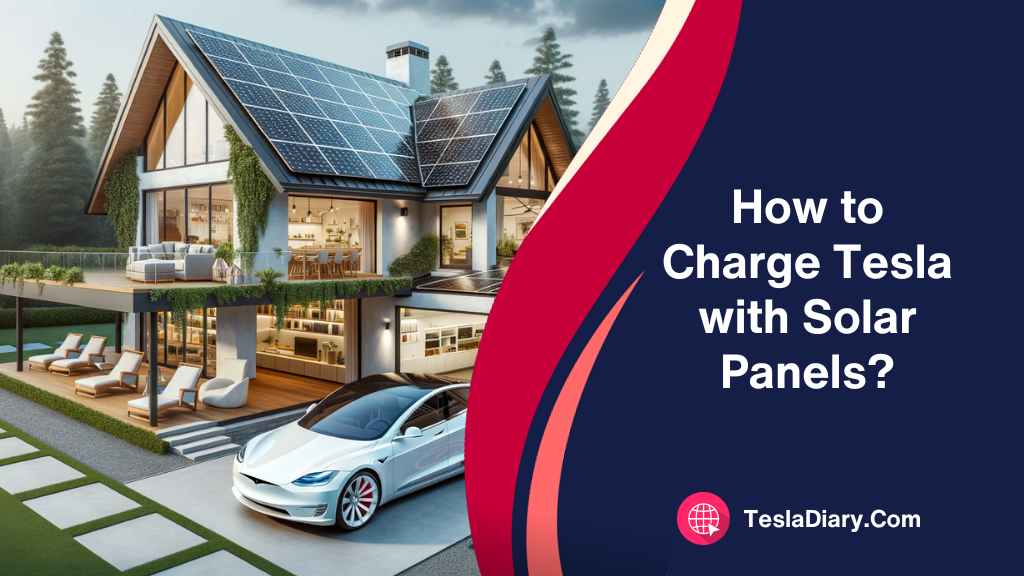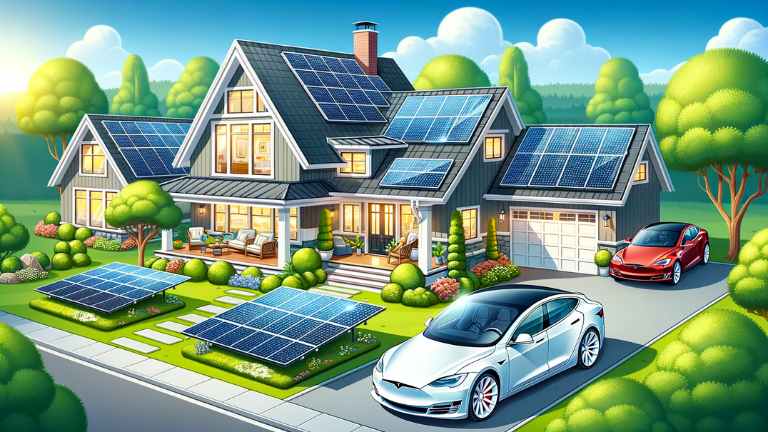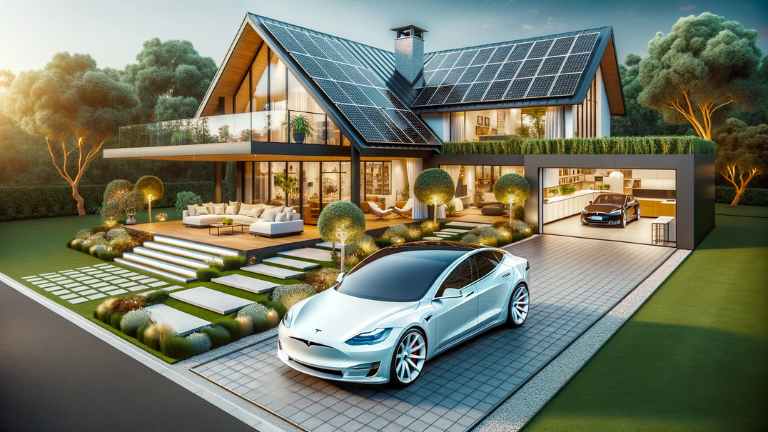One of the ongoing concerns for EV owners is finding sustainable ways to charge their vehicles.
The most environmentally responsible solution is harnessing the power of the sun by charging your Tesla with solar panels at home.
In this comprehensive guide, we will walk you through the steps and concepts needed to set up your own solar-powered Tesla charging system.

Can You Charge a Tesla with Solar Panels?
Yes, you can charge a Tesla electric vehicle (EV) with solar power. Charging a Tesla with solar power involves setting up a solar panel system to generate electricity from sunlight and then using that electricity to charge your Tesla.
Understanding the Basics
Before diving into the practical aspects of setting up a solar charging system for your Tesla, it’s crucial to understand the fundamental principles at play.
How Solar Panels Work
At the heart of a solar power system are solar panels, also known as photovoltaic (PV) panels. These panels are made up of semiconductor materials, typically silicon, which absorb sunlight and convert it into electricity through a process known as the photovoltaic effect.
When sunlight strikes the solar cells, it dislodges electrons, creating an electrical current.
The Concept of Solar Energy Conversion
Solar panels generate direct current (DC) electricity, which must be converted into alternating current (AC) electricity for use in your home and for charging your Tesla.
This conversion is accomplished by an inverter, a critical component of any solar power system.

Key Components of a Solar Power System
- Solar Panels: These capture sunlight and generate electricity.
- Inverter: Converts DC electricity from solar panels into AC electricity for household use and EV charging.
- Battery Storage (optional): If you want to store excess solar energy for nighttime charging or emergencies, you can add a battery storage system to your setup.
- Electric Vehicle (Tesla): Your Tesla is the final piece of the puzzle. It’s essential to ensure compatibility with the solar charging system.
With these components in mind, let’s move on to the next steps in setting up your solar-powered Tesla charging station.
Assessing Your Solar Potential
Now that you understand the basics, it’s time to assess your solar potential. This involves determining how much energy you need, evaluating the suitability of your location for solar energy production, sizing your solar panel system accordingly, and estimating the costs involved.
Calculating Your Energy Needs
Before you install solar panels, you must know how much electricity you require to power your home and charge your Tesla. Review your past utility bills to get an idea of your monthly energy consumption.

Evaluating Your Location for Solar Viability
The amount of sunlight your location receives throughout the year will significantly impact the efficiency of your solar panels.
Consider factors like your geographical location, local climate, shading from nearby trees or buildings, and the orientation of your roof.
Sizing the Solar Panel System
The size of your solar panel system should align with your energy needs and the available space for installation. Typically, solar systems are measured in kilowatts (kW).
A larger system will produce more electricity but may require more space and incur higher costs.
Estimating the Costs Involved
Setting up a solar charging system is an investment, but it can yield substantial savings over time.
Calculate the initial costs of solar panels, inverters, and optional battery storage, as well as ongoing maintenance expenses.

Choosing the Right Equipment
Selecting the appropriate equipment for your solar-powered Tesla charging system is crucial to ensure optimal performance and compatibility. Let’s explore the key considerations for each component:
Selecting High-Quality Solar Panels
Investing in high-quality solar panels can make a significant difference in the long-term performance and efficiency of your solar system. Look for panels from reputable manufacturers with a proven track record of reliability.
Inverter Options and Compatibility with Tesla Charging
Your inverter plays a pivotal role in converting the DC electricity generated by solar panels into the AC electricity used by your home and Tesla.
Ensure that the inverter you choose is compatible with your Tesla’s charging requirements. Tesla vehicles typically use Level 2 chargers, which operate at 240 volts AC.
Battery Storage or Grid Connection Considerations (Optional)
While not essential, battery storage can provide significant benefits, especially if you want to use solar energy for nighttime charging or during power outages.
Evaluate the capacity and capabilities of various battery storage solutions to determine if they align with your needs.
Instead of storage, you could contribute access to electricity generated by your solar panels to the grid and get the electricity back at nighttime. By doing this, you will be able to save on battery expenses while utilizing the full power of your solar panels.
Tesla-Specific Charging Equipment and Adapters
To charge your Tesla efficiently using solar energy, you may need specific Tesla charging equipment and adapters.
Tesla offers various charging options, including the Wall Connector and various adapters for standard electrical outlets.
Choosing the right equipment is a critical step toward building a reliable and efficient solar charging system.
Once you’ve selected your components, it’s time to move on to the installation process.
Installation Process
Setting up a solar charging system for your Tesla involves several steps, and the complexity of the process may vary depending on your level of expertise. Here’s an overview of what to expect during installation:
Hiring a Professional vs. DIY Installation
Decide whether you’ll hire a professional solar installer or attempt a DIY installation. While a professional installer ensures safety and compliance with local regulations, DIY installations can be cost-effective for those with the necessary skills and knowledge.
However, I strongly recommend going with professional installation since you are going to mess with a lot of electrical components and wiring. And, you won’t want any mistake in doing that.
Permitting and Regulatory Considerations
Check local building codes and regulations to determine if permits are required for your solar installation. Compliance with these regulations is essential to avoid legal issues and ensure the safety of your system.
Mounting Solar Panels
Solar panels can be mounted on your roof or installed on the ground, depending on available space and your location’s suitability.
Ensure that the panels are positioned to receive maximum sunlight throughout the day.
Connecting the Solar Panels to Your Inverter
Proper wiring and connection between the solar panels and inverter are critical for the efficient transfer of electricity. This step may require electrical expertise.
Setting Up Tesla’s Charging Equipment
Install Tesla’s charging equipment, such as the Wall Connector or other charging stations, following Tesla’s installation guidelines.
Make sure the equipment is safely and securely mounted.
Or if you already have your Wall Connector mounted, you just need to ensure that the connection to solar and grid is made properly so that they can switch back and forth for an efficient and seamless charging experience.
Monitoring and Maintenance
Once your solar-powered Tesla charging system is up and running, it’s essential to monitor and maintain it to ensure it continues to perform optimally over the long term. Here are the key aspects of monitoring and maintenance:
Installing Monitoring Systems
Consider installing monitoring systems that allow you to track the energy production of your solar panels and the performance of your entire solar power system.
Many modern systems come with online portals or mobile apps that provide real-time data on energy generation.
I recommend going with a service that provides you with real-time data on electricity production, consumption, and basic troubleshooting guidelines on the app.
Regular Cleaning and Maintenance of Solar Panels
Dust, dirt, and debris can accumulate on your solar panels over time, reducing their efficiency.
Schedule regular cleaning to ensure your panels can capture maximum sunlight. Cleaning can typically be done with a soft brush, water, and a gentle detergent.
If you live in a clean environment without much air pollution, you can clean the panels once every six months. However, depending on the air quality in your area, the cleaning frequency needs to be adjusted.
Benefits of Using Solar Energy to Charge Your Tesla
Charging your Tesla with solar power offers numerous advantages:
- Reduced reliance on the grid, leading to potential cost savings.
- A lower carbon footprint, as solar power is a clean and renewable energy source.
- Increased energy independence and resilience in the face of power outages.
How Long to Charge a Tesla with Solar Panels?
It could take about 10 hours to several days for solar panels to fully recharge your Tesla batteries. The time it takes to charge a Tesla with solar panels can vary widely based on several factors:
- Solar Panel System Size: The size and number of solar panels in your system determines how much electricity it can generate. Larger systems can produce more electricity, which means faster charging for your Tesla.
- Sunlight Availability: The amount of sunlight your solar panels receive affects charging times. Solar panels generate the most electricity on sunny days and less on cloudy or overcast days. Seasonal variations and shading from trees or buildings can also impact solar panel efficiency.
- Tesla Battery Capacity: The capacity of your Tesla’s battery pack plays a significant role in charging times. A larger battery will take longer to charge fully compared to a smaller one.
- Charging Equipment: The type of charging equipment you use can influence charging times. Tesla vehicles typically support Level 1 and Level 2 charging. Level 1 charging uses a standard 120-volt household outlet and is slower, while Level 2 charging uses a 240-volt outlet and charges faster.
- Charging Settings: You can configure your Tesla to charge at different rates, which can impact charging times.
- Battery State of Charge: If your Tesla’s battery is nearly empty, it will take longer to charge compared to topping up a partially charged battery.
- Battery Management: Tesla vehicles come with onboard battery management systems that optimize charging. These systems may limit charging speed to protect the battery’s health, particularly when using third-party chargers.
To estimate the time it takes to charge your Tesla with solar panels, you’ll need to consider the specifics of your solar panel system, your Tesla model, and the current conditions. For instance, a small solar system may take several days to fully charge a Tesla with a large battery, while a larger system with abundant sunlight could provide a full charge in a single day.
Conclusion
Charging your Tesla with solar panels at home is not only an eco-friendly choice but also a smart financial investment. By understanding the basics of solar energy, choosing the right equipment, and following the installation and maintenance guidelines, you can harness the power of the sun to charge your electric vehicle.
In addition to the tangible benefits, such as cost savings and reduced carbon emissions, adopting solar power for your Tesla charging system aligns with a broader vision of a cleaner, greener future. As you embark on this journey, remember that you’re making a positive impact on the environment and contributing to a more sustainable world for generations to come. So, get ready to hit the road with the sun as your fuel source and enjoy the benefits of a solar-powered Tesla.

